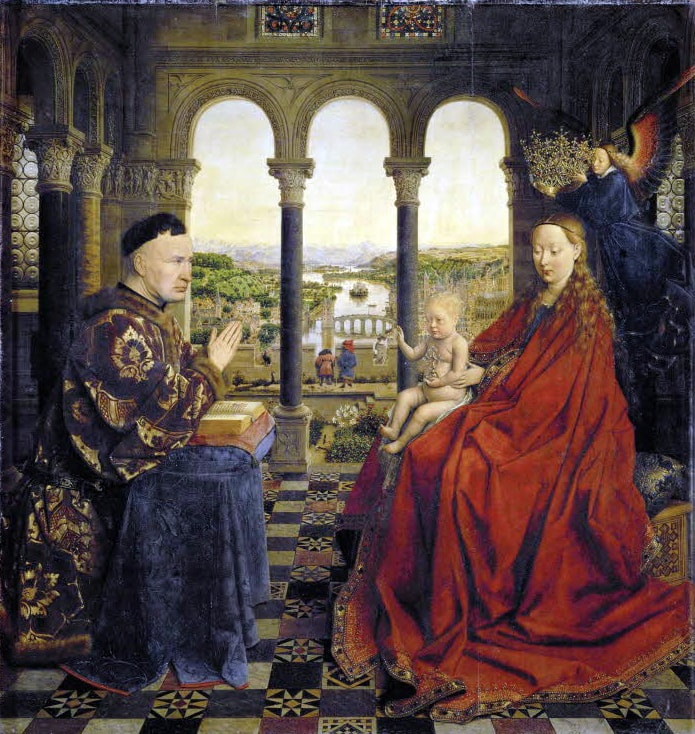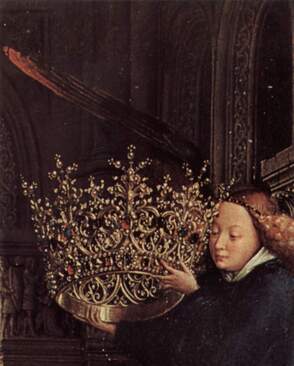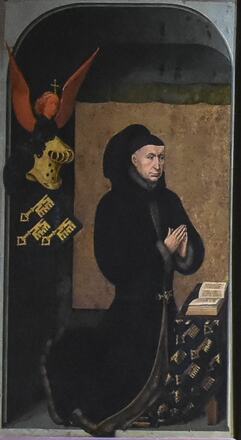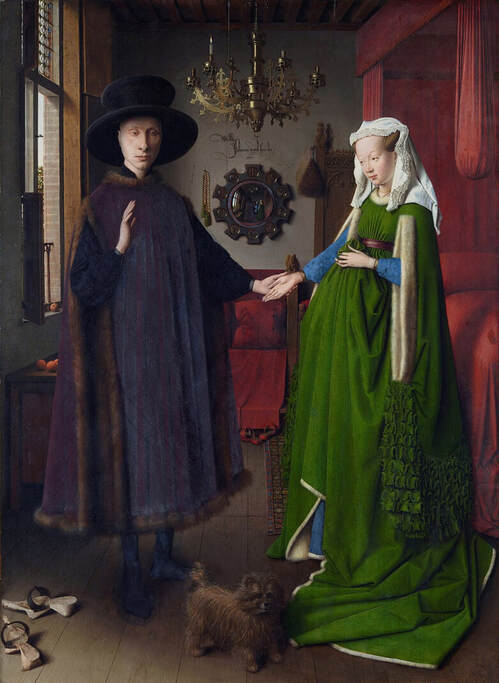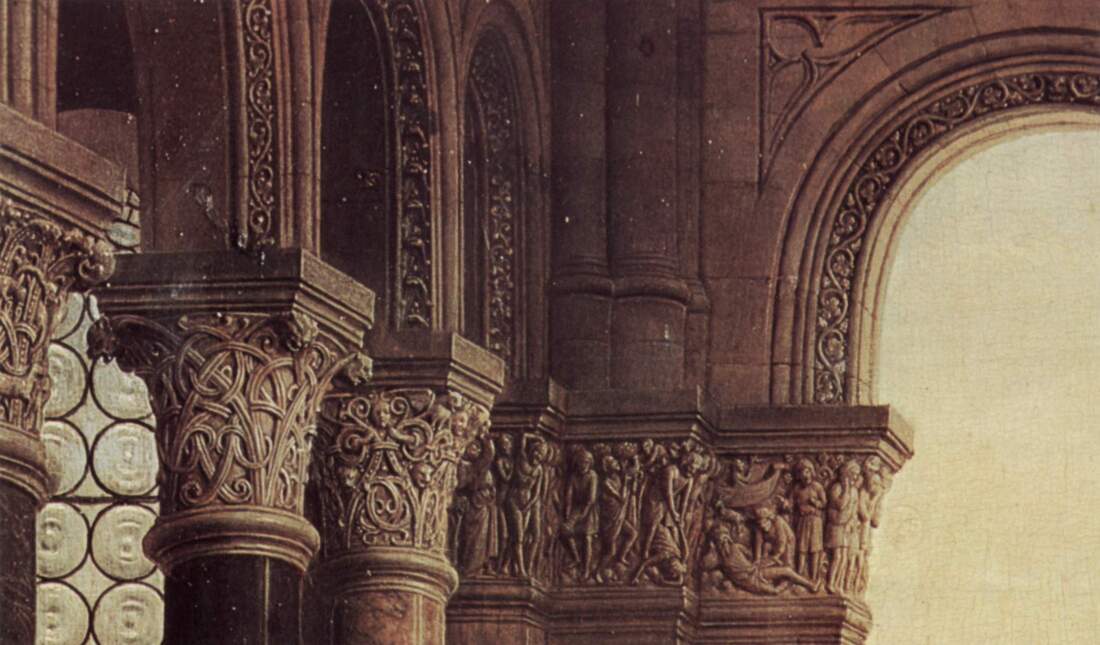|
Where? Second floor, room 818 of the Richelieu wing in the Louvre
When? Between 1435 and 1440 Commissioned by? Nicolas Rolin, the Chancellor of Burgundy under Duke Philip the Good.
What do you see? Nicolas Rolin kneels down in front of the Virgin Mary who is holding Baby Jesus. Rolin's hands are folded in prayer, and he has an open book on his lap. He does not seem to look at Mary and Jesus. Mary wears a red gown with jewelry in it and looks down with humility. Baby Jesus has his right hand raised to bless Rolin and holds an orb with a cross (called a globus cruciger) in his left hand.
In the background, you can see a city on the left, a river and bridge in the middle, and several church towers on the right, above the head of Jesus.
Backstory: This painting is also known as The Virgin with Chancellor Rolin or The Virgin of Chancellor Rolin. The painting entered the collection of the Louvre in 1805. Nicolas Rolin commissioned this painting for the Saint Sebastian chapel (the Rolin family chapel) in the Notre-Dame-du-Châtel church in Autun, near Dijon in France. This was the church that Rolin visited when he grew up and where his ancestors were buried. Rolin was the main patron of this church, and there was even an elevated walkway from his house to the church such that he could enter it at any time. Symbolism: The cross that Jesus holds in his left hand reminds the viewers that Jesus died for the sins of mankind. The three arches in the middle background represent the Holy Trinity, God, Jesus, and the Holy Spirit. The peacocks are a symbol of immortality. The flowers in the middle symbolize different virtues of Mary. Behind the praying hands of Rolin is a church tower to symbolize his faith. The church towers behind Jesus signify him as the center of the Church. The bridge in the background unites the common people and the Church. Some people have identified the city in the background as the New Jerusalem, but others are not so sure about this interpretation.
Who is Van Eyck? Jan van Eyck was born around 1390 in Maaseik, Belgium, and died in 1441. He is one of the most important representatives of the Northern Renaissance. Until 1429, he was a court painter of Duke Philip the Good, which explains why he was asked for this painting. During this time, he undertook several diplomatic missions across Europe for the Duke. Among other countries, he visited Italy, where he could learn from the innovative Italian painters.
Van Eyck was ahead of his time by using a realistic and naturalistic style in his work. This was, in part, possible because he was one of the first painters who used oil paint. He has had a big influence on future artists, including Sandro Botticelli. One of his most famous works hangs in the National Gallery in London and is The Arnolfini Portrait, which was probably painted a year before the Madonna of Chancellor Rolin.
Fun fact: The capital above the head of Rolin contains some very interesting details. It contains the following scenes:
However, Van Eyck seems to have freely interpreted these Biblical stories as he has altered some details. For example, to the right of Noah, four men are depicted. These men should represent the sons of Noah. However, Noah only had three sons. It seems likely that Van Eyck has altered these scenes to draw some parallels with Rolin’s life. Rolin, for example, had four sons and each of the ‘sons of Noah’ seem to represent the different roles of the sons of Rolin. Interested in a copy for yourself? Poster or canvas.
Written by Eelco Kappe
References:
0 Comments
Leave a Reply. |
Categories
All
|
- Home
- Blog
-
Museums
- Alte Pinakothek
- Art Institute of Chicago
- Baltimore Museum of Art
- Barber Institute of Fine Arts
- Bargello
- Barnes Foundation
- British Museum
- Church of Sant’Anastasia
- Cleveland Museum of Art
- Courtauld Institute of Art
- Detroit Institute of Arts
- Frans Hals Museum
- Galleria Borghese
- Gallerie dell'Accademia
- Getty Museum
- Guggenheim
- Hermitage Museum
- Kunsthistorisches Museum
- Kunstmuseum Basel
- Legion of Honor Museum
- Louvre
- Mauritshuis
- Metropolitan Museum of Art
- Musee d’Orsay
- Museum of Fine Arts in Boston
- Museum of Modern Art
- National Gallery in London
- National Gallery of Art
- National Museum in Poznań
- Norton Simon Museum
- Ny Carlsberg Glyptotek
- Palace of Versailles
- Palazzo Pitti
- Palazzo Vecchio
- Petit Palais
- Philadelphia Museum of Art
- Prado
- Pushkin Museum
- Ravenna Art Museum
- Rijksmuseum
- San Diego Museum of Art
- Santa Maria delle Grazie
- St. Peter's Basilica
- Städel Museum
- Statens Museum for Kunst
- Tate Britain
- Tate Modern
- Timken Museum of Art
- Uffizi
- Vatican Museums
- Wallace Collection
-
Artists
- Altdorfer
- Anguissola
- Berlin Painter
- Bosch
- Botticelli
- Boucher
- Bronzino
- Bruegel the Elder
- Brunelleschi
- Cabanel
- Caillebotte
- Canova
- Caravaggio
- Carpeaux
- Cezanne
- Cimabue
- David
- Degas
- Delacroix
- De Maria
- Donatello
- El Greco
- Fontana
- Fra Angelico
- Fragonard
- Gauguin
- Gentileschi
- Gericault
- Gonzalez-Torres
- Goya
- Hals
- Hogarth
- Hokusai
- Ingres
- Leonardo da Vinci
- Lippi, Filippo
- Longhi, Barbara
- Lorrain
- Makovsky
- Manet
- Massys
- Matisse
- Merian
- Michelangelo
- Mochi
- Modigliani
- Monet
- Panini
- Parmigianino
- Perugino
- Picasso
- Pisanello
- Raphael
- Rembrandt
- Renoir
- Reynolds
- Rivera
- Rodin
- Rubens
- Scultori
- Seurat
- Steen
- Tintoretto
- Titian
- Toulouse-Lautrec
- Turner
- Uccello
- Van der Weyden
- Van Dyck
- Van Eyck
- Van Gogh
- Van Hemessen
- Vasari
- Velazquez
- Vermeer
- Veronese
- Vigée Le Brun
-
Locations
- Books
- About Us

